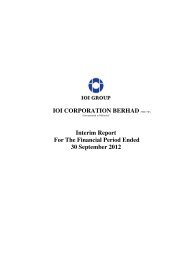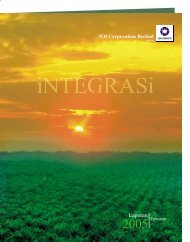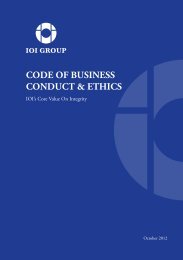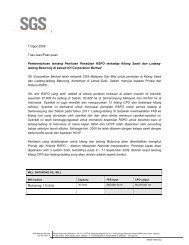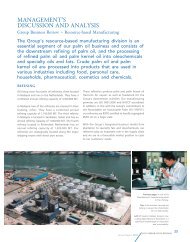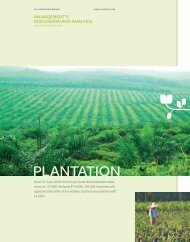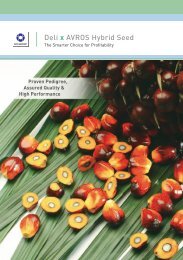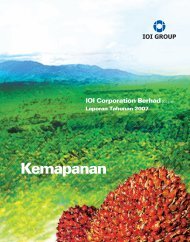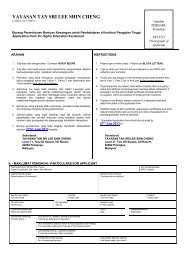Annual Report 2012 - IOI Group
Annual Report 2012 - IOI Group
Annual Report 2012 - IOI Group
Create successful ePaper yourself
Turn your PDF publications into a flip-book with our unique Google optimized e-Paper software.
NOTES TO THEFINANCIAL STATEMENTS5. SIGNIFICANT ACCOUNTING POLICIES (Continued)5.1 Basis of Consolidation (Continued)5.1.1 Business Combinations (Continued)Business combinations before 1 July 2011Under the purchase method of accounting, the cost of business combination is measured at the aggregate of fairvalues at the date of exchange, of assets given, liabilities incurred or assumed, and equity instruments issued plus anycosts directly attributable to the business combination.At the acquisition date, the cost of business combination is allocated to identifiable assets acquired, liabilities assumedand contingent liabilities in the business combination which are measured initially at their fair values at the acquisitiondate. The excess of the cost of business combination over the <strong>Group</strong>’s interest in the net fair value of the identifiableassets, liabilities and contingent liabilities is recognised as goodwill (see Note 5.12 to the financial statements ongoodwill). If the cost of business combination is less than the interest in the net fair value of the identifiable assets,liabilities and contingent liabilities, the <strong>Group</strong> will:i. reassess the identification and measurement of the acquiree’s identifiable assets, liabilities and contingentliabilities and the measurement of the cost of the business combination; andii.recognise immediately in profit or loss any excess remaining after that reassessment.When a business combination includes more than one exchange transaction, any adjustment to the fair values of thesubsidiary’s identifiable assets, liabilities and contingent liabilities relating to previously held interests of the <strong>Group</strong> isaccounted for as a revaluation.5.1.2 SubsidiariesSubsidiaries are entities (including special purpose entities) in which the <strong>Group</strong> and the Company have the ability tocontrol the financial and operating policies so as to obtain benefits from their activities. Control exists when the <strong>Group</strong>has the power to govern the financial and operating policies of an entity. The existence and effect of potential votingrights that are currently exercisable or convertible are considered when assessing the existence of control.In the Company’s separate financial statements, investments in subsidiaries are stated at cost less impairment losses, ifany. Investments accounted for at cost shall be accounted for in accordance with FRS 5 Non-current Assets Held for Saleand Discontinued Operations when they are classified as held for sale (or included in a disposal group that is classifiedas held for sale) in accordance with FRS 5.When control of a subsidiary is lost as a result of a transaction, event or other circumstance, the <strong>Group</strong> wouldderecognise all assets, liabilities and non-controlling interests at their carrying amount and to recognise the fair valueof the consideration received. Any retained interest in the former subsidiary is recognised at its fair value at the datecontrol is lost. The resulting difference is recognised as a gain or loss in profit or loss.The consolidated financial statements incorporate the financial statements of the Company and all its subsidiariesmade up to the end of the reporting period, using consistent accounting policies.Subsidiaries are consolidated from the date of acquisition, being the date on which the <strong>Group</strong> obtains control, andcontinue to consolidate until the date that such control ceases.132<strong>IOI</strong> CORPORATION BERHAD<strong>Annual</strong> <strong>Report</strong> <strong>2012</strong>



